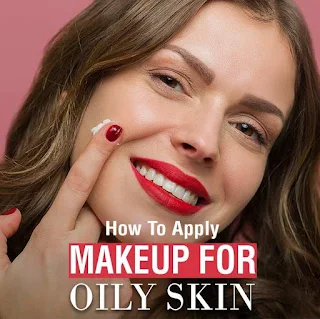Oily
skin is a huge hassle and is difficult to find the right makeup
product.Keep your makeup oil- and smudge-proof with these makeup tips.
After washing your face, apply a moisturizer right away. If you can, pick a moisturizer with SPF for added sun protection.
Always prime your skin first.
After washing your face, apply a moisturizer right away. If you can, pick a moisturizer with SPF for added sun protection.
Always prime your skin first.
You should at least prime oiliest areas (think: theT-Zone -- forehead, nose, and chin) with an oil-free, anti-shine primer. Put it on after you've cleaned your face but before you put on foundation, powder, or other makeup.
Use a setting spray
Use a setting spray after you apply the primer. This will ensure the makeup sticks to the skin. Women with oily skin tend to suffer from melting or smudging makeup.
Prep your peepers.
To cut down on eye makeup creasing, avoid priming your lids with concealer, something that Warren says many women with dark circles or redness do.
Instead, use a primer specifically designed for eyelids. The base creates a perfect canvas for eye shadow and liner while absorbing crease-causing oils throughout the day.
Apply eye primer
The last step of prepping the skin is to apply eye primer under the eyes. This will help the concealer and base makeup adhere to the skin better.
Conceal & Cover
Apply a light coverage concealer under the eyes.
Apply your foundation
Apply foundation evenly on your face. If you can, use airbrush foundation instead due to its finish. An airbrush finish is more matte than shiny or glossy.
Define your brows
Work on your brow game. Fill in your brows with a pencil and then finish up with a brow gel to add color and definition.
Eyeshadow prep
Apply lid primer to prepare the eyes for eyeshadow. Eyeshadow primers will help keep eye color in place longer so you don’t need to retouch frequently.
A peachy pink eyeshadow looks great in the summer. You can use your fingers to dab some color onto your lids once the primer is dry.
Finish your eye makeup
Curl your eyelashes and get it ready for some eyeliner and mascara action!
For your eyeliner, pick a waterproof one so that it doesn’t smudge on your eyes.
Apply mascara on your top and bottom lashes.
Apply pink or peach blush on your cheekbones for added color.
To complete the look, finish with a nude lipstick or lip gloss, whichever you prefer. A glossy finish is preferred especially in daytime.
Tips: Makeup Tricks And Hacks For Battling Oily Skin
Now that you have an idea of how to apply makeup when you battle with oily skin and what products you can use, here are a bunch of tips and hacks that will come in handy forever!
We’ve already stressed upon the importance of using a primer for your face, but it’s also important to prep your eyelids. If you have oily eyelids, then for the love of eyeshadow, prep them with a product specifically designed for your eyelids. This step not only creates the perfect base for your shadow but also prevents it from creasing and fading through the day.
Less is more! This applies to your powder as well. Going overboard often backfires by pushing more oil than usual through your pores.
If you want to fix that shine midday, use a blotting sheet and press it on the oily area, and then roll it off your skin. This will soak up any excess oil without wiping your makeup off.
To touch-up your face in times of crisis, carry a mineral powder in your bag! This won’t give you the caked-on powder look and will help make your face look shine-free, even, and natural. Crisis averted!
When you have oily skin, dermatologists recommend exfoliating three to five times a week to slough away dead skin cells and control excess oil production.
It’s important to use skin care products that specifically address your skin concerns. For oily skin, products containing ingredients like tea tree, bentonite or kaolin clay, and sulfur are amazing choices – be it your face cream, mask or cleanser.
It’s important to not only moisturize your skin but also keep it hydrated. Drink a ton of water and incorporate products that contain hyaluronic acid into your regimen.













